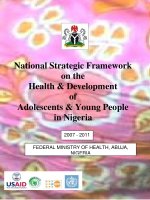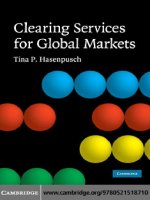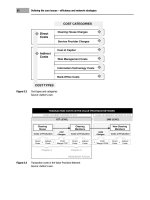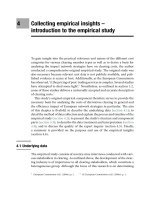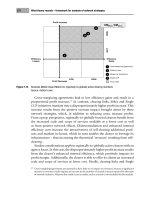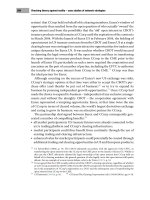National Strategic Framework on the Health & Development of Adolescents & Young People in Nigeria ppt
Bạn đang xem bản rút gọn của tài liệu. Xem và tải ngay bản đầy đủ của tài liệu tại đây (316.86 KB, 128 trang )
i
National Strategic Framework
on the
Health & Development
of
Adolescents & Young People
in Nigeria
2007 - 2011
FEDERAL MINISTRY OF HEALTH, ABUJA,
NIGERIA
ii
ACRONYMS
AHD Adolescent Health and Development
AIDS Acquired Immune Deficiency Syndrome
ASRH Adolescent Sexual and Reproductive Health
BMI
FLHE
Body Mass Index
Family Life and HIV & AIDS Education
FMOH Federal Ministry of Health
GAR Gross Attendance Ratio
GER Gross Enrollment Ratio
HIV Human Immunodeficiency Virus
NAR Net Attendance Ratio
NER
NHMIS
MIS
Net Enrollment Ratio
National Health Management Information System
Management Information Systems
RTA
RH
Road Traffic Accident
Reproductive Health
STI Sexually Transmitted Infections
UNDCP United Nations Drug Control Programme
UNFPA United Nations Population Fund
UNICEF United Nations Children’s Fund
WHO
YPHD
World Health Organisation
Young People’s Health and Development
iii
TABLE OF CONTENTS
Section Title Page
Acronyms ii
Foreword
edgement
iv
Acknowl vi
Preface
mmary
viii
Executive Su xii
1
Introduction
Analysis
1
2 Situation 4
2.1 Nutrition 4
2.2 Accidents
e
6
2.3 Drug Abus 8
2.4 Education 13
2.5
2.6
Career and employment
Parental responsibilities and social
18
23
adjustment
2.7 Mental health 27
2.8
.9 2
Spirituality and rights
Sexual and reproductive health
30
31
3
4
Framework for Strategic Action
Implementation/Monitoring and
36
78
Evaluation
List of Contributors 5
104
iv
FOREWORD
Young people form a significant population group in
terms of demographic parameter and are a unique
population in terms of characteristics as a result of
their developmental processes. They face unique
challenges, some of which may compromise their
health and development potentials if not well
addressed. Since young people represent the future
of the country, one of the most important
commitments a country can make for future
economic, social and political progress is to address
eir health and development needs. th
In Nigeria, there has been a growing recognition of
the need to respond effectively to the health and
developmental challenges of young people. In this
respect, the Federal Government, through the Federal
Ministry of Health (FMOH) developed a National
Adolescent Health Policy in 1995. A National
Adolescent Reproductive Health Strategic Framework
was developed in 1999, reproductive health having
been identified as a key issue in adolescents. No
strategic framework was however produced for other
priority areas of adolescent health and development
indicated in the 1995 policy. However, several
important changes have occurred in the area of
adolescent health and development nationally and
internationally between 1995 when the old policy was
developed and the current time. This has
necessitated a revision of the policy and development
of a comprehensive strategic framework to reflect the
new realities as follows: (a) sexual behaviour; (b)
reproductive health; (c) nutrition; (d) accidents; (e)
drug abuse; (f) education; (g) career and employment;
and (h) parental responsibilities and social
djustment. a
This publication, National Strategic Framework on the
Health and Development of Adolescents and Young
People in Nigeria has been developed to aid the rapid
translation of the policy into actions in line with the
commitment of the Nigerian government and people
to the development of the younger generations. The
framework covers all the priority areas outlined in the
revised policy, and takes due cognizance of the role
of various stakeholders, including government
agencies, civil society organizations (including
community-based organisations, non-governmental
organizations, and faith-based organizations), the
academia, the private sector, international
evelopment partners and other stakeholders. d
It is my sincere hope that with the implementation of
this document, the health and development needs of
young people in Nigeria will be better met with a
resultant marked improvement in their quality of life,
which will contribute towards our national aspiration of
achieving the Millennium Development Goals and
ensuring a better future for our nation.
Prof Eyitayo Lambo
Honourable Minister of Health
v
vi
ACKNOWLEDGEMENT
The development of this strategic framework which
translates the National Policy on the Health and
Development of Adolescents and Young people to
actionable plans was a partnership between the
Federal Ministry of Health and the World Health
Organisation (WHO) with active collaboration of many
other development partners including various Federal
Ministries and government agencies, non
governmental organizations, and the young people
hemselves. t
I hereby express my appreciations to all partners who
participated in the process as well as various
technical resource persons. I particularly wish to
acknowledge the contributions of Dr. O. Odujinrin,
WHO Reproductive Health Adviser in planning and
developing this document. I seize this opportunity to
note the immense support of the Enabling HIV &
AIDs, TB and Social Sector Environment (ENHANSE)
Project to the National Policy review process with
particular reference to Mrs. Charity Ibeawuchi, also
the Reproductive Health Adviser. The efforts of our
lead consultants, Drs. Adesegun-ola Fatusi and
Olubunmi Asa in ensuring the successful outcome of
he development process are highly appreciated. t
I deeply appreciate the hard work of my officers,
whose dedication has led to the final output of the
document. In particular, I wish to thank Dr. M.A.
Odeku, National RH Coordinator and the Adolescent
Reproductive Health team: Mr. D. O. Ajagun, National
ARH Coordinator, Mrs. A.O. Etta, Mrs. R. Idris and
rs. A.A. Odunuga. M
ni, MFR
Dr. Shehu Sule m
Director, CDPA
vii
REFACE
viii
P
The concern about the health and development of
adolescent has been expressed in various Regional
and International instruments, including the 1985
International Year of the Youth (UN General
Assembly), the 1990 UN convention on the Rights of
the Child, The OAU African charter on the Rights and
Welfare of the Child and more recently, the UN
Special Session on Children. The WHO regional
committee for Africa also concluded in 1995 that the
health situation of adolescents is not satisfactory and
subsequently adopted the Adolescent Health Strategy
for African Region and endorsed the resolution urging
member states to accord adolescent health and
development priority in their national and social
economic development agenda.
Although adolescents are generally considered
physically healthy, they are vulnerable to several
unique health problems, such as early childbearing
and unwanted pregnancies with its health
consequences. Other include higher maternal and
child mortality, unsafe abortion; sexually transmitted
infections including HIV/AIDS; and sexual exploitation
and abuse. Fifteen million young women between the
ages of 15-19 give birth each year accounting for
over 17% of all annual births in the least developed
countries and as high as 40% of all maternal
mortalities in some countries in the Region. Also
between 1 and 1.4 million adolescents women have
abortions in developing countries each year. Lack of
accurate information and limited access to
adolescent-friendly health services are major
contributory factors to the poor reproductive health
status of young people in Nigeria which is reflected in
the fact that only 57% of young people in 2005 knew
all the transmission routes for HIV. Other common
problems of adolescents include malnutrition, injuries
and disability as a result of risk-taking activities,
parasitic and waterborne diseas
ix
es and use of alcohol
and other harmful substances.
The development of this National Strategic
Framework on the Health & Development of
Adolescents & Young People was a fall out of the
heightened interest in adolescent health issues,
strong collaboration
x
between development partners
nd the National Adolescent Reproductive Health
olescent health and development with
a
Conference, 1999.
The frame work compliments the National Policy on
Adolescent and Young Persons’ Health &
Development and aimed at translating the policy into
actionable plans to improve the health and
development of adolescents in Nigeria. It outlined
major areas of adolescent care and needs and
described broad strategies for intervention in the
areas of sexual behaviour; reproductive health;
nutrition; accidents; drug abuse; education; career
and employment; and parental responsibilities and
social adjustment. It also set out specific objectives
for improving ad
recommended activities and indicator for measuring
achievements.
Adolescence offers both a challenge and an
opportunity for investment in human development.
Adolescents’ resourcefulness and energy have been
shown to contribute to improvement of their standard
of living as well as that of their families and
communities. The next 3-8 years will be a challenging
period for adolescent health in view of the rapidly
changing
xi
economic, social and technological
nvironment in most countries of the regions and the
d to foster the partnership
quired for effective implementation of the framework
r improvement of adolescent health and
.
WHO Representative
e
approaching targets for Millennium Development
Goals.
WHO is well situated to continue to provide technical
support for translation of strategies articulated in the
framework to actions an
re
fo
development in Nigeria
xii
EXECUTIVE SUMMARY
In Nigeria, there has been a growing recognition of
the challenge of young people’s health issues and the
need to address this challenge. To respond to the
challenges of young people’s health and
development, the Federal Government, through the
Federal Ministry of Health (FMOH) developed a
National Adolescent Health Policy in 1995 and a
National Adolescent Reproductive Health Strategic
Framework in 1999 which complements the policy
and aimed at translating the policy into actionable
lans. p
The goal of this strategic framework is to facilitate the
implementation of the National Adolescent Health
Policy that aims to improve the quality of life of young
persons in Nigeria. In addition to the other thematic
areas (sexual and reproductive health, nutrition,
accidents, drug abuse, education, career and
employment, and parental responsibilities and social
adjustment) already addressed by the previous
strategic framework this new strategic framework
aims to capture all the domains of adolescent health
(including adolescent mental health, spirituality and
rights for purpose of completeness) that the national
olicy focuses on. p
The contemporary issues under each of the thematic
areas are to be addressed through the following
strategies:-
xiii
• Advocacy and social mobilization
• Promotion of healthy behaviours through
education and skills development
• Equitable access to quality health services
lth services including school hea
• Capacity building
• Research promotion
• and participation Young people involvement
• Monitoring and evaluation
This strategic framework can be used by all
stakeholders to achieve the ultimate goal of the
National Adolescent Health Policy which is an
improved quality of life for all young people in Nigeria.
It serves as a guide for stakeholders to adapt to their
contexts and raise resources for all or specific
activities and their implementation. To ensure
success, the Federal Ministry of Health (FMOH) will
undertake the responsibility of disseminating the
framework and mobilizing resources for its
implementation to the extent possible. The ministry
will also collaborate with all partners for the
successful and effective implementation of the
ramework. f
This strategy has built into it, appropriate indicators
under each thematic area with which programmes
can be monitored and evaluated Government
agencies shall monitor activities in the sector within
their mandate, and according to the appropriate tier of
government. A comprehensive evaluation of the
implementation of the framework will be undertaken
nationally every five years. The results of monitoring
and evaluation activities will be used to improve
programme planning and implementation as well as
he development of future framework.
xiv
t
1
1. INTRODUCTION
Adolescents as defined by the World Health Organisation
(WHO) refer to people between the ages of 10 and 19
years, while youths refer to persons between the age range
of 15 and 24 years, and the term young people is used to
cover both groups (10-24 years). Young people form a
significant population group in terms of demographic
parameter as they constitute about a fifth of the human
population globally and are rapidly increasing in terms of
absolute number. Young people are also a unique
population in terms of characteristics and needs and they
face unique challenges as a result of their level of
development and the societal situation.
One of the most important commitments a country can
make for future economic, social and political progress and
stability is to address the health and development needs of
its young people. In Nigeria, there has been a growing
recognition of the challenge of young people’s health issues
and need to address this challenge. As evidence from
various local and national surveys have shown, young
people in Nigeria face the challenges of early sexual
2
initiation, early marriage, and unsafe sexual practices,
among others, with the consequences of increasing rate of
unwanted pregnancies, unsafe abortions, and sexually
transmitted infections (STIs), including HIV and AIDS.
To respond to the challenges of young people’s health and
development, the Federal Government, through the Federal
Ministry of Health (FMOH) developed a National
Adolescent Health Policy in 1995. Between 1995 and
2006, several important changes have occurred in the area
of adolescent health and development nationally and
internationally, which has necessitated a revision of the
policy to reflect the new realities.
The broad aim was to ensure that the policy is up-to-date
vis-a-vis current health trends and policy frameworks
including the revised National Health Policy and the
Millennium Development Goals and to also achieve a good
fit between the policy and the strategic framework. The
policy identified major areas of adolescent health care
needs and described broad strategies for intervention to
address the following: (a) sexual behaviour; (b)
reproductive health; (c) nutrition; (d) accidents; (e) drug
3
abuse; (f) education; (g) career and employment; and (h)
parental responsibilities and social adjustment.
As a follow up, a heightened interest in adolescent health
issues and strong collaboration between development
partners led to the organisation of National Adolescent
Reproductive Health Conference in 1999. One of the
outputs of the conference was a National Adolescent
Reproductive Health Strategic Framework, which
complements the policy and aimed at translating the policy
into actionable plans. This new strategic framework aims to
capture all the domains of the adolescent health (including
adolescent mental health, spirituality and rights for purpose
of completeness) that the national policy focuses on.
4
2.
SITUATION ANALYSIS
2.1. NUTRITION
To be healthy, young people must have the right kinds and
amounts of food. Health and nutrition are closely linked:
disease contributes to malnutrition, and malnutrition makes
an individual more susceptible to disease. During
adolescence, average weight doubles and height may
increase by more than 15%. The demands of physical
growth can only be met by a balanced intake of nutrients,
and a lack or excess of any nutrient may lead to health
problems later.
Many young people are becoming economically active, due
to poverty and family circumstances, and may be required
to perform heavy manual or domestic labour, which may
further compound their problem of inadequate diet. Young
people may not have adequate nutrition as a result of
poverty or due to specific food habits, which have to do
with preference for snacking and food fad. Available
5
evidence also indicate that even where intake of calories
and protein is sufficient, shortages of other nutrients such
as iron, calcium and some vitamins may be relatively
common because of peculiar feeding habits.
Over-nutrition and obesity among young people, resulting
from excessive consumption of certain foods and lack of
physical exercises, are also increasing in incidence. Young
people are often attracted by processed and refined foods.
Such foods are often high in fats and sugars, and excessive
consumption of these foods results in malnutrition. The
establishment of a preference for food containing these
substances may lead to early bio-physiological changes and
ultimately pathological changes and disease.
Adolescent females may sometime face more challenges
than their male counterparts due to biological and social
circumstances. As a result of gender discrimination, for
example, young females may receive less food in general
compared to their male siblings, or less of certain foods
such as meat. Teenage pregnancy, when such occurs,
further compounds the precarious nutritional state of many
6
young girls, and they are particularly at high risk of
anaemia.
2.2. ACCIDENTS AND VIOLENCE
Accidents constitute one of the major causes of death and
disability among young people throughout the world and
account for as many as half of all deaths of people aged 10-
24 years in many countries. Four settings constitute the
major site for accidents among young people: home
settings, work or school setting, road, and recreational
settings. Increase in community upheavals, including
political clashes and inter-communal violence, as well as
natural disasters also increase the exposure of young people
to accidents and trauma.
Sexual assault, physical harassment and psycho-social
abuse of young females occur commonly in cult-linked
campus-based violence. Adolescent girls and other young
females may also be victims of intimate partner abuse in
dating relationships and domestic as well as sexual violence
in family settings. Exposure to violence through the mass
media, peer pressure and lack of conflict resolution skills
7
are some of the other factors known to be associated with
violence among young people. The various types of
accidents and violent activities contribute to high injury-
related morbidity and mortality among young people
Young people may also be at a higher risk of accidents than
other population groups as a result of factors such as
alcohol intake, exuberance, lack of experience, a feeling of
invulnerability, and risk-taking behaviour that comes with
the need to demonstrate independence and courage.
Environmental conditions can also contribute greatly to
risk, and it is often a combination of risk-taking and an
unsafe environment that leads to injury. Many young
people especially in developing countries start work too
young and are especially at risk since they often work in
conditions more appropriate for adults, may not have fully
developed psychomotor skills, are not as aware of potential
hazards, and may be careless because of tiredness. Leisure
and sports-related accidents, burns, poisonings and falls
also represent major risks to young people.
While population-based and national data are scarce and
disaggregated in Nigeria about the involvement of young
people in road-traffic accidents (RTA), practical
8
experiences showed that RTA impact significantly on the
health and well-being of young people and may result in
life-long and severe disabilities such as spinal cord injuries.
With the steady rise in the number of commercial
motorcycles on the Nigeria roads, the careless attitudes of
the riders and the high proportion of young people involved
in the use of motorcycles, either as the commercial rider or
passenger, the mortality and morbidity rates relating to
motorcycle accidents are increasing among young people in
Nigeria. The non enforcement of the relevant laws
compelling riders and passengers of motorcycles to wear
safety helmet has also contributed to the increased rate of
head injury and case fatality among victims of motorcycle
accidents.
2.3. DRUG AND SUBSTANCE ABUSE
Drug and substance abuse poses a significant hazard to the
health and development of young people and cuts across
age and social class. The quest for new experiences and the
rebellious nature of the young predisposes them to drug
abuse. The average age of drug users/abusers has declined
in recent years, and multiple drug use has become more
9
common. Indeed, age at first use of drug has been found to
be as early as eleven years (NDLEA 1999). Teenagers in
particular are predisposed to drugs by peer pressure,
youthful curiosity and the urge to experiment. The ability
of drugs to stimulate euphoria, boldness and high levels of
energy also make them attractive to young people.
Some of the reasons identified in research reports for the
use/abuse of substances by young people in Nigeria include
the following: predisposition to experimentation, rebellion
and desire for independence; peer pressure; defects in
personality such as low self-esteem; notion of ‘machismo’
characterized by independent risk-taking behavior;
engagement of older siblings in drug taking; employment
outside the home such as teenagers who drop out-of- school
to take up menial jobs in market places and motor parks;
frustrations caused by tension between improved levels of
education and shrinking employment opportunities;
parental deprivation as a result of separation, divorce, death
of a spouse or persistent discord between spouses in the
home; advertisement such as those associating smoking
with success, glamour, popularity, youthful vigor and good
health; rapid urbanizations (social change) with the
breakdown of the family’s effective cultural and social
10
controls; and exposure to high risk jobs (such as tobacco
company) and environments that encourage drug use (such
as bars). The abuse of drugs is also higher among
marginalized, vulnerable groups of young people, such as
street children, commercial sex workers, commercial
drivers, okada riders and students
Alcohol and tobacco constitute a major threat to the health
of young people. They are referred to as “gate way drugs”
as most young people who abuse drugs and other
dangerous substances started with alcohol and cigarettes.
The illicit drug most commonly abused by young people in
Nigeria is cannabis. It is illegally cultivated in different
parts of Nigeria and is relatively cheap. These factors make
cannabis readily available. As one study showed, almost a
tenth (8.2%) of young people between the ages of 10-19
years have used cannabis at some time in their lives
1
. There
is also a high incidence of non-medical or self-medicated
use of benzodiazepines and psychotropic substances, which
are easy to obtain as a result of the ineffective enforcement
of laws on their sale and distribution. The use of
1
UNDCP, 1999. Report of the rapid situation assessment of drug
abuse in Nigeria, Lagos
11
prescription drugs such as amphetamines and barbiturates,
common in adult world, also appear to be increasing among
young people. Although the use of highly addictive hard
drugs such as cocaine and heroine appear to be low in
Nigeria, it is a matter of concern that many young people
use multiple drugs. The practice of sniffing volatile organic
solvents, such as petrol and glue and abuse of some
unconventional substances not yet under international
control e.g. pawpaw leaves, zakami, haukatayaro e.t.c. has
also been documented from various parts of Nigeria.
Drug taking has a close inter-relationship with crime. This
is most evident with respect to the consumption of hard
drugs such as cocaine and heroine, which, because of their
cost and highly addictive nature, drive their users to
robbery or prostitution as a means of maintaining their
habit. The ready availability and use of drugs in tertiary
educational institutions has been linked to the upsurge of
violent cult activities. It is believed that armed robbers,
vigilante militants, as well as cult members use drugs as a
means of stimulating boldness.

